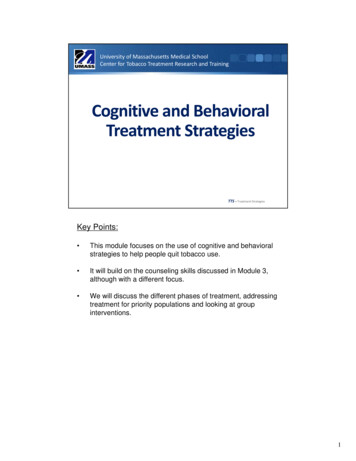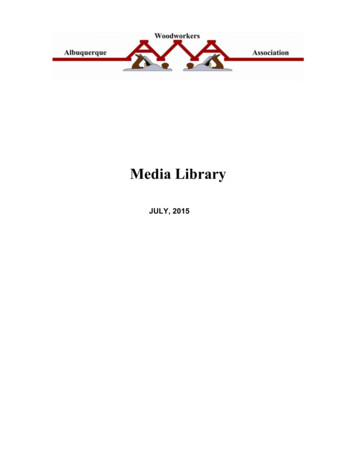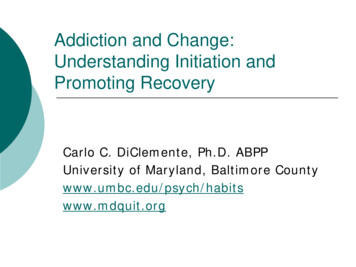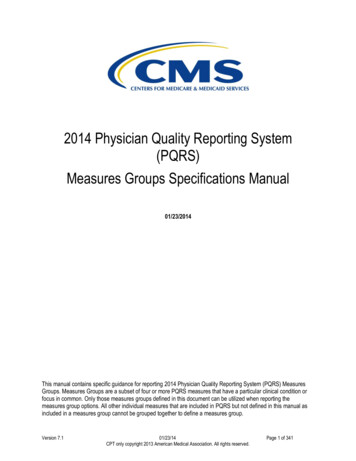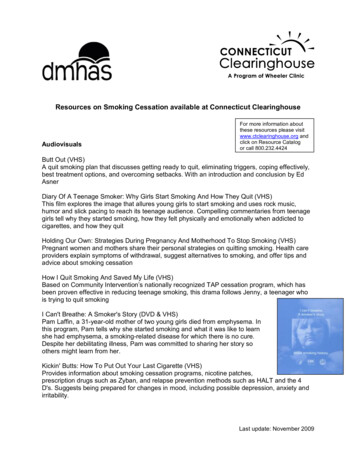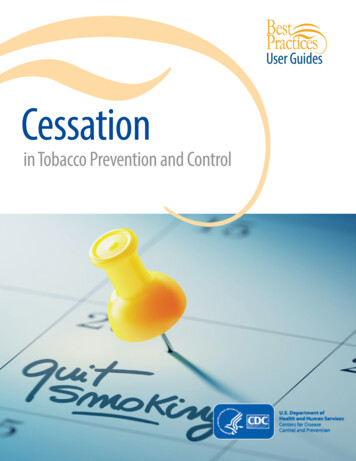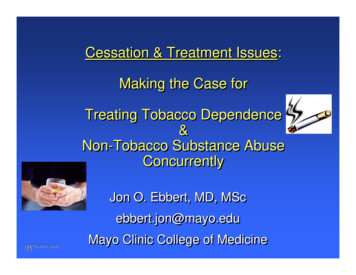
Transcription
Cessation & Treatment IssuesIssues::Making the Case forTreating Tobacco Dependence&Non-Tobacco Substance AbuseNon-TobaccoConcurrentlyJon O. Ebbert, MD, MScebbert.jon@mayo.eduMayo Clinic College of Medicine
Goals & Objectives Relationship between tobacco & substanceabuse/mental health issue Theoretical rationale for concurrenttreatment What the literature shows
Smoking and Substances of Abuse Smokers are more likely to report use of a sedative,stimulant, or opiate in last 12 months than non-smokers Alcohol/heroin/cocaine/marijuana users Smoking prevalence 75-98% Alcohol Heavy alcohol use correlates with heavy smoking 80-95% of patients in alcohol treatment smoke Risk of alcoholism among heavy smokers 10 x that of non-smokersSmoking alcoholics make up 25.9% of all smokersSullivan et al, Curr Psychiatry Rep, 2002Degenhardt et al, Nico Tob Res, 2001
Smoking & Alcohol Abuse More tobacco dependent Smoke more cigarettes Experience more withdrawal symptoms whenthey quitHurt et al, Addiction, 1995Marks et al, J Subst Abuse Treat, 1997
Mortality After Alcoholism Treatment Observed mortality 2.5 times expected Tobacco-related disease caused 51% of deaths Alcohol-related disease caused 34% of deaths Leading causes: CAD,cirrhosis,COPDHurt et al, JAMA, 1996
Rationale of Treating Alcohol and TobaccoDependence Concurrently Tobacco: serious cause of morbidity/mortality Closely-related behaviorsClosely-related Eliminates a cue to relapse Cross-addiction neuroadaptationCross-addiction Common message Apply same treatment philosophy Protected milieu (inpatient programs) to initiatean attempt
Barriers to Treating Alcohol and TobaccoDependence Concurrently Too Hard Tobacco not a ““real”real” drug Consequences not immediate Not as disruptive to patient’s life if don’t treatpatient’sdon’t Adds unnecessary stress to treatment Jeopardize recovery
Simultaneous Treatment of Tobacco Use& Other AddictionsHelp or Hinder?What does the evidence show?
Interest in Tobacco Dependence Treatment Patients reporting for substance abuse treatment (n 272) Interest in quitting tobacco at some time 72% of cocaine users 70.5% of heroin users Interest in tobacco treatment at time of treatment for otherdrugs 52% cocaine users 50% of alcohol users 42% of heroin usersSees et al, J Subst Abuse Treat, 1993
Tobacco Dependence & Other Addictions:Inpatient Treatment Prospective study101 patients (50 control & 51 intervention) in inpatienttreatment for other non tobacco drugs InterventionIntervention:: tobacco dependence treatment Consultation 10 intervention sessions Relapse prevention program ControlControl:: usual careHurt et al, Alcohol Clin Exp Res, 1994
Tobacco Dependence & Other Addictions:Inpatient Treatment OutcomesOutcomes:: Smoking cessation 11.8% intervention 0% control Alcohol/other drugs relapse rate 31.4% intervention 34.0% controls ConclusionConclusion:: Tobacco dependence treatment enhanced smoking cessationNo adverse effect on abstinence from the nonnon-tobacco drug of dependenceHurt et al, Alcohol Clin Exp Res, 1994
Relapse to Drug Use & Smoking Drug Abuse Treatment Outcome Study 2316 smokers Smoking was associated with greaterabstinence from drug use after completion ofdrug abuse treatment (P .04).Lemon et al, Addictive Behaviors, 2003
Relapse to Drug Use & Smoking Meta-analysis of 19 RCTsMeta-analysis Smoking cessation was associated witha 25% increased likelihood of long termabstinence from alcohol and illicit drugsProchaska, J Consult Clin Psychol, 2004
Recommendations Tobacco use treatment should be acomponent of drug abuse and mental healthtreatment Tobacco abstinence should not be used as asurrogate for success of drug abuse/mentalhealth treatment plan
Alcohol Abuse and Tobacco Dependence:Treatment Recommendations Treatment success with behavioral interventionhas been observed Pharmacotherapy Higher doses of nicotine patch Longer duration of therapy Combination therapy Bupropion is effectivePatten, J Stud Alcohol, 1998Hurt et, Addiction, 1995Martin et al, 1997Dale et al, 1995Hayford et al, Br J Psychiatry, 1999
Concomitant Use of Antidepressants& Bupropion SR Contraindications for Bupropion SR use History of seizures Previous head/CNS trauma Eating disorders Bulimia Anorexia nervosa MAOI’s (14 days before initiation)MAOI’s
Concomitant Use of OtherAntidepressants & Bupropion SR SSRIs (Selective Serotonin Reuptake Inhibitors) Citalopram [[Celexa ]Celexa ] Fluoxetine [Prozac ; Sarafem ; Symbyaz ][Prozac ;Sarafem ;Symbyaz ] Paroxetine [[Paxil ;Paxil ; Paxeva ]Paxeva ] Fluvoxamine [[Luvox ]Luvox ] Lexapro [[escitalopram]escitalopram]Lexapro Zoloft [[sertraline]sertraline] Celexa [[citralopram]citralopram] Venlafaxine (blocks reuptake of both 55-HT-HT and NE)
Concomitant Use of Antidepressants &Bupropion SR May use simultaneously Monitor for antidepressant side effects Increased blood levels May considering decreasing dose ofantidepressant before starting
Concomitant Use of Antidepressants &Bupropion SR May use simultaneously Limited CYP-450 interactionsCYP-450 Unlikely drug interactions w/ SSRI & venlafaxine SSRI bupropion SR is preferred augmentationstrategy among community psychiatrists Depression non-respondersnon-responders Bupropion – noradrenergic complementsserotonergic mechanism of SSRIs
Concomitant Use of Antidepressants &Bupropion SR Subjects on SSRI or venlafaxine Received bupropion SR 150 mg po qd Significant increase in venlafaxine blood levels P .001 No significant changes in plasma levels of SSRIsKennedy et al, J Clin Psychiatry, 2002
Concomitant Use of Antidepressants &Bupropion SR 42 patients with SSRI-induced sexual dysfunctionSSRI-induced Randomized to bupropion SR 150 mg twice/dayfor 4 weeks ConclusionsConclusions:: Bupropion SR is an effectiveantidote to SSRI-induced sexual dysfunctionSSRI-inducedClayton et al, J Clin Psychiatry, 2004
Concomitant Use of Antidepressants &Bupropion SR 28 patients On SSRI who failed to have clinical response Bupropion SR 150-300 mg/day added150-300 Side effects: headache, insomnia, dry mouth ConclusionsConclusions:: Supports the use of bupropion SR inthe augmentation of SSRIsDeBattista et al, J Clin Psychopharmacol, 2003
Concomitant Use of Antidepressants &Bupropion SR: Monitoring May increase blood concentrations of otherantidepressants Monitor patients for Worsening of depression or suicidality Unusual changes in behavior Especially at the initiation of therapy or whenthe dose increases or decreases
Goals & Objectives Relationship between tobacco & substanceabuse/mental health issue Theoretical rationale for concurrenttreatment What the literature shows
Smoking & Depression Smokers have: Higher lifetime prevalence of depression Higher prevalence of anxiety disorder Increased withdrawal symptoms Increased depression w/ abstinence Negative moods trigger relapse
Smoking and Depression Smokers report more depressive symptomsthan nonsmokers Of smokers enrolled in clinical trials, 34-48%34-48%have been classified as depressed Depressed smokers less likely to quitquit:: 9.9% vs.17% at 9 years Presence of depressive symptoms predictspoorer outcome following cessation
Schizophrenia Patients with chronic schizophrenia smoke 70 - 90% prevalence Postulated that negative symptoms result fromdeficiency of dopamine in prefrontal areas Postulated that positive symptoms result fromexcess of dopamine in mesolimbic system
Anxiety Smoking twice as high among patients withanxiety (who do not have depression) Patient with Panic Disorder, 40% Controls, 25%Pohl, Psych Res, 1992
Bulimia 42 Inpatients, 52% regular smokers 2/3 of these reported smokingdecreased their appetiteBulik, Int J Eating Disorders, 1992
Goals & ObjectivesGoals & Objectives Relationship between tobacco & substance abuse/mental health issue Theoretical rationale for concurrent treatment What the literature shows Relationship between tobacco & substance abuse/mental health issue Theoretical rationale for concurrent


